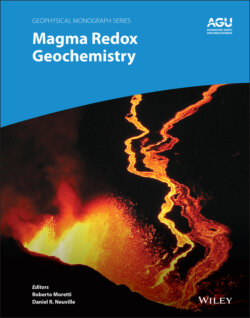Читать книгу Magma Redox Geochemistry - Группа авторов - Страница 39
3.1.2. Fe‐Based Oxybarometry
ОглавлениеEquilibria involving iron are useful because iron is the most abundant multivalent element in the solid Earth and is present in the common rock‐forming minerals. For example, the oxygen fugacity of the equilibrium reaction of the pure phases fayalite goes to ferrosilite plus magnetite:
(3.4)
can be calculated from the free energy change of the reaction using Equation 3.3. The equilibrium constant can be written:
(3.5)
where represents the activity of the end‐member component (e.g., ferrosilite) within the mineral phase (e.g., orthopyroxene). In the case of pure phases, the activity is equal to unity, and so the following relationship holds true:
(3.6)
In experimental systems, oxygen fugacity can be imposed by an invariant buffer reaction involving pure phases (activities equal to unity, for example nickel [Ni] and nickel oxide [NiO]). In natural systems, oxygen fugacity is determined by equilibria involving multi‐component silicate minerals, melts, and gases; mineral phases are rarely found as pure end‐member compositions. This requires us to relate mineral compositions to component activities. Accurate activity‐composition models are therefore important when comparing the fO2 recorded by a single equilibrium reaction across a wide range of compositions, and even more so when comparing the fO2 recorded by different fO2 equilibria – when the accuracy, and not just the precision, of each equilibrium reaction is paramount. We relate the measured compositions of natural phases to the activities of end‐member components (e.g., the activity of pure magnetite in spinel, ) via equations like
(3.7)
Equation 3.7 describes the spinel oxybarometer (Ballhaus et al., 1991; O’Neill & Wall, 1987; Wood & Virgo, 1989) and its form prompts a review of several important points.
Any calculation of fO2 assumes that all phases that fix the activity of oxygen are present and in equilibrium. For example, fO2 is not constrained by the spinel oxybarometer if orthopyroxene is absent from the assemblage (unless the activity of silica can be constrained by some other means). Likewise, the composition of magnetite records fO2 only in the presence of ilmenite (Buddington & Lindsley, 1964). We can also see from the above equations that the activity of oxygen will rise with temperature such that it is convenient to refer to a reference buffer. In this contribution we reference the quartz‐fayalite‐magnetite (QFM) buffer (Frost, 1991) because its pressure‐dependence parallels adiabatic melt ascent (Kress and Carmichael, 1991), facilitating comparison of magmas equilibrated at different pressures and temperatures.
It also follows from the thermodynamic treatment above that the bulk rock ratio of ferric to total iron (Fe3+/∑Fe = Fe3+/[Fe3+ + Fe2+]) in crystalline rocks cannot be equated to oxygen fugacity, because the former varies with mineral mode (extensive property) whereas the latter varies with component activity (intensive property). In melts (and glasses), steric effects are greatly reduced, such that melt (glass) Fe3+/∑Fe ratios can be related to fO2; however, this does not mean that the Fe3+/∑Fe ratios of melts vary systematically with fO2 independent of composition. With melts too, Fe3+/∑Fe ratios must be related to fO2 after considering composition because oxide components in the melt can stabilize or destabilize Fe3+ relative to Fe2+ at given fO2 (e.g., Borisov et al., 2018; Kress & Carmichael, 1991; O’Neill et al., 2018).
Based on iron’s role in both setting and monitoring fO2 (Frost, 1991; D. J. Frost & McCammon, 2008), prior Fe‐based compilations of fO2 as a function of tectonic setting have relied on either spinel oxybarometry (e.g., Ballhaus, 1993; Wood et al., 1990), magnetite‐ilmenite equilibria (e.g., Frost & Lindsley, 1992), or bulk rock and/or sediment Fe3+/∑Fe ratios (e.g., Carmichael, 1991; Lecuyer & Ricard, 1999). In this chapter, we do not compile fO2 calculated for bulk “glass” Fe3+/∑Fe ratios because in most cases the metadata provided in publications are absent or insufficient to ensure that the samples have not suffered post‐eruptive oxidation or are free of phenocrysts, both of which have been shown to compromise the fidelity of fO2 proxies (Bezos & Humler, 2005; Brounce et al., 2017; Cottrell & Kelley, 2011; Grocke et al., 2016; Stolper & Bucholz, 2019; Bezos et al., 2021). Further, while very convenient for generating large datasets and informing box models (e.g., Brounce et al., 2019; Canil & Fellows, 2017; Evans, this volume; Evans & Tomkins, 2011; Evans et al., 2012; Lecuyer & Ricard, 1999; Stolper & Bucholz, 2019), applications of bulk “glass” or whole rock Fe3+/∑Fe ratios are limited because the Fe3+/∑Fe ratios of crystalline rocks and mixtures (like cumulates and sediments) cannot be directly equated to fO2 – as detailed above.
